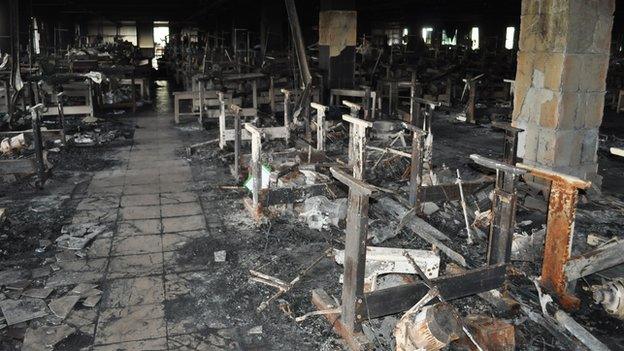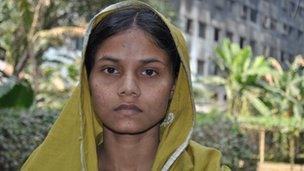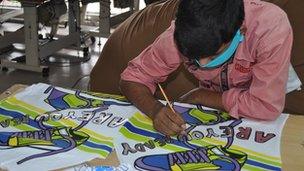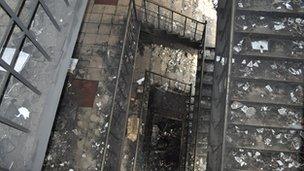Bangladesh garment industry looks to revive image
- Published

The fire at the Tazreen Fashions factory is the worst such incident in the history of the sector in Bangladesh
Shati Akter Shuchona's voice trembles when she tries to recount what happened when a devastating fire swept through the factory floor she was working on last November.
The Ms Shuchona, 22, was on the fourth floor of Tazreen Fashions Limited building, near Dhaka, helping to stitch sweatshirts for a major western brand when she heard a fire alarm.
"It was around 7pm in the evening. We were under pressure to finish an important order," she tells the BBC. "Suddenly there was a fire alarm."
Unfortunately, it was not a false alarm. What set it off was the worst ever incident in the history of Bangladesh garment industry.
"All of a sudden I heard someone was shouting and there was lots of smoke. Then the lights went off and everything was dark."
Estimates suggest that more than 1,100 workers were inside building when the fire started in the ground floor, where yarn and fabric had been stored.
More than 110 people were killed in the blaze. Dozens were seriously injured.
The government has since launched an enquiry into the incident. It has suggested legal action against nine mid-level officials, who it alleges "barred the workers from leaving the burning factory".
It has also accused the factory owner of "severe negligence".
Ms Shuchona alleges her supervisor also asked her not leave: "He said they were fixing a problem with the alarm."
'Still haunts me'
There was no way to escape. All the three staircases of the nine-storey building came down to the same ground floor.

Shati Akter Shuchona was one of the workers who jumped to safety from the fourth floor of the factory
Thick, black smoke was spreading fast through the staircase and as the blaze spread through the upper floors, the heat was intense.
Coughing severely, Ms Shuchona and some of her colleagues ran towards the other corner and managed to break a window. They jumped from the fourth floor.
"I was badly hurt and could not breathe properly for many days. But many of my colleagues who were standing next to me died."
"The incident still haunts me," she says, as her voice chokes and eyes turn moist while recollecting the incident.
Naseema Akther, another female worker who survived the blaze, says she left the factory as soon as she heard the alarm, despite her supervisor asking her to ignore it.
"I just thought about my children, so I hurriedly walked out. Some of my friends were not so lucky," she says.

Bangladeshi fire service officials say the Tazreen Fashions Limited factory did not have a valid fire safety certificate at the time of the fire and the mid-level officials failed to act quickly when the fire started.
"They killed time. That was the precious time for the lives," Abu Naim Mohammad Shahidullah, the director general of Fire Service and Civil Defence tells the BBC.
"If the workers had come out as soon as they heard the fire alarm, many lives could have been saved."
For his part, the owner of the factory, Delwar Hossain told the BBC that he will respond to the allegations "if they give me the details of negligence".
The telephone line dropped during the conversation and repeated attempts by the BBC to contact him again were unsuccessful.
Dent to image?
Bangladesh has come a long way in the past three decades. It is now the world's second-largest exporter of ready-to-wear clothes, next only to China.
Last year it exported more than $19bn (£12bn; 14bn euros) worth of clothes.
It is also hoping to get more Chinese orders, as labour costs in China continue to rise.
However, incidents like this one could prove a big hurdle to future growth.
Even almost two months after the fire, the industry is struggling to shake off the negative image.
The government and the Bangladesh Garment Manufacturers and Exporters Association (BGMEA) have given compensation to the families of those killed and to those injured.
They admit that more needs to be done to improve safety in some of the factories, but are hopeful that things will improve.
"We have improved a lot in the last 30 years. There are some world class factories here and there are some are low-standard factories also. We hope that we will come out of this problem," says Siddiqur Rahman, vice-president of the BGMEA.
More regulation?
At the time of the incident, the Tazreen factory was making clothes for many international brands including Wal-Mart and C&A.
During my visit to the burnt down factory, I found clothes made for many other western brands on various floors of the building.
However, many western retailers, including Wal-Mart, say the factory was producing clothes without their authorisation and they blamed it on their suppliers.
They insist that they source their clothes from factories which comply with safety standards.

The incident has raised concerns over the safety standards at some factories in Bangladesh
The tragic incident has not only exposed poor safety standards but also uncovered chinks in the supply chain.
Industry insiders say suppliers or middlemen for top international brands sometime source their clothes from factories which produce at cheaper costs, probably without the knowledge of the buyers.
A risk associated with this is that these factories may not have the required safety standards.
They fear that orders may dip if they cannot meet the deadlines or if the cost of manufacturing escalates.
However, firms such as Wal-Mart argue that the suppliers and factory owners should take more responsibility.
"We firmly believe our suppliers and their factories must meet our supplier standards and we recognise the cost of meeting those standards will be part of the cost of the goods we buy," says Megan Murphy, Wal-Mart's international corporate affairs manager.
The argument between factory owners and global firms over who is responsible for better safety standards has been going on for years.
For Bangladeshi workers such as Ms Shuchona and Ms Akther who escaped death by a few inches or seconds, the answer could not come any sooner.
- Published17 December 2012
- Published7 December 2012